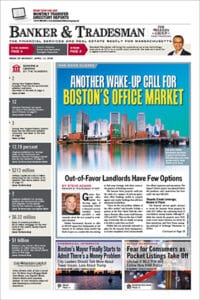
Observers of New Hampshire’s multifamily sector are split on how much new development might happen next year given murky economic factors. iStock illustration
New Hampshire’s multifamily housing market faces a murky future heading into the new year, as cautious developers, bankers and investors wait to see how the Fed handles interest rates and how the incoming Trump administration’s policies impact the economy in 2025.
Early bank data indicates that the multifamily lending market improved through the first nine months of the current year in New Hampshire, with multifamily purchase lending jumping by 18.4 percent to nearly $90 million compared to the same period in 2023, according to figures compiled by The Warren Group, the real estate analytics firm and publisher of Banker & Tradesman.
The Warren Group’s data doesn’t cover all multifamily lending in the state through Oct. 31, but the purchase-loan numbers do point to increased investor interest in the multifamily sector in the Granite State, some of it apparently due to the Federal Reserve’s interest rate cut in September.
Then again, the 10-year Treasury bond yield, considered a benchmark for the direction of mortgage rates and other loan products, began increasing in early October from about 3.7 percent to as high as 4.46 percent on Nov. 13, before settling down to around 4.1 percent in early December, according to industry data.
To some, the higher Treasury yields effectively offset the benefits of the Fed’s fall interest rate cut, leaving the multifamily lending sector – and most other lending sectors – in a sort of limbo, industry figures say.
Combined with currently high construction costs that are hampering new multifamily developments, the outlook for 2025 is murky at best, said William Norton, president of Norton Asset Management in Manchester, New Hampshire’s biggest city.
“It’s very unclear where we’re going,” said Norton. “The economy seems a little fragile.”
Others are more positive – at least when it comes to multifamily housing and the huge pent-up demand for housing in New Hampshire, as in much of the rest of New England.
“We’re seeing an uptick in investor activity,” said Biria St. John, vice chairman of brokerage firm CBRE’s Boston office, which covers much of New England, including New Hampshire. “Despite the run-up in [Treasury yields], investors have kept going. They’re taking the long view.”
The Cautiously Optimistic
Nazar Vincent, the principal owner of Bridgewater Development and Avatar Construction, is bullish on multifamily housing – at least in Manchester.
The Massachusetts-based construction collaborative is currently constructing the 77-unit Grand Central Suites in downtown Manchester. The complex at 21 Central St. is now about 60 percent complete.
Meanwhile, Vincent’s firms are planning to build a 262-unit apartment complex at 533 Elm St. near Manchester’s downtown. The project has already been approved by the city Zoning Board of Appeals, he said.
But Vincent acknowledged that his projects benefit from two other factors that not all multifamily investors and developers can emulate.
First, his two companies can work more easily together to get complicated projects off the ground. And second, the firm is taking advantage of key government policies to build in Manchester, which has an officially designated federal “Opportunity Zone” designed to spur economic development via tax incentives.
Vincent said there are concerns moving forward, such as whether rents will remain high enough to support new multifamily construction. He also expressed frustration with rising construction costs.
But he said he’s cautiously optimistic about the multifamily housing sector in Manchester.
“If the Fed lowers the interest rate by a least a [percentage] point, we’re going to be in really good shape,” he said. “I’m also hedging on Donald Trump and what he does. He really knows real estate and what the industry needs.”
CBRE’s St. John agreed there are worrisome signs in the market that could hamper the multifamily sector, including higher Treasury yields and questions about rental rates moving forward.
But, he said, New Hampshire has become an attractive market for multifamily investors, due to its strong economy, business-friendly tax policies and solid rent rates.
The More Cautious
Some may see signs of improvement on the multifamily-housing front.
But Chris Logan, president and CEO of the Bank of New Hampshire, isn’t one of them, noting multifamily construction loans haven’t picked in any discernable way at his bank.
“Our volume has been flat year-over-year,” he said. “And I see 2025 flat as well.”
As for new multifamily developments, a pair of factors are hampering the sector: higher finance and construction costs, he said.
“Those two costs are straining the possibilities out there,” he said. “The economics of multifamily projects are challenging.”
Another Fed rate cut would definitely help the economy, but it’s unclear what the Fed might do in 2025 due to ongoing fears of inflation, said Logan.
“We’d love to see more multifamily activity, but much depends on the economy,” he said.
Norton, of Norton Asset Management, said there’s looming challenge facing multifamily projects: How much higher can rents go when construction costs keep going up and debt costs aren’t going down?
Norton said he’s seen studies showing some people are paying up to 50 percent of their income on rent.
“When you hit those levels, there isn’t much more room to go,” he said. “The rents can’t keep going up like they have.”






